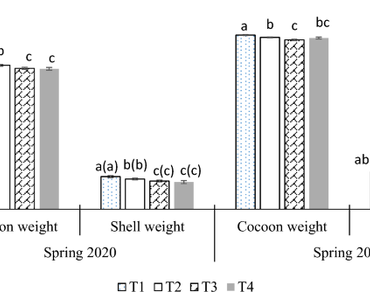Leaf position of mulberry (Morus alba L.) affects silkworm growth, silk cocoon yield and quality
Nguyen Hong-Hanh, Nguyen Thi-Nhai, Pham Thi-Phuong, Le Thi-Tuyet-Cham, Bui The-Khuynh, Jang Dong-Cheol, Vu Ngoc-Thang
Research Articles | Published: 04 July, 2024
First Page: 1681
Last Page: 1688
Views: 2809
Keywords: Mulberry, Leaf position, Larvae, Cocoon
Abstract
Mulberry plant (Morus alba L.) have long recognized as a main food plant for silkworm (Bombyx mori L.) worldwide, so the quality of mulberry leaves is essential factor for successful silkworm industry. This research examined the effects of mulberry leaf positions on yield and quality of silkworm cocoons. Leaf positions were ranked from shoot tip to base of the branch with youngest fully developed leaf ranked as + 1 leaf. Silkworms were fed by 4 respective mulberry leaf position treatments: T1—top leaves (from the + 2 to + 4 leaves); T2—middle leaves (from the + 5 to + 7 leaves); T3—basal leaves (from the + 8 to + 10 leaves), and T4—mixed leaves (mixture of all leaves). Here, we showed that silkworms fed by top leaves (T1) exhibited higher larvae weight, and produced higher cocoon weight, shell weight, and cocoon yield than those fed by other leaf position treatments. These results were attributed by the high moisture and protein content in tender leaves, which helped to increase the weight of larvae, leading to higher cocoon weight, shell weight, and cocoon yield. However, silk quality was found to be superior when larvae were fed with middle leaves (T2) due to high leaf dry weight and carbohydrate content. Consequently, middle leaves were recommended for achieving both optimal yield and quality of the silk cocoon.

References
Adeduntan SA (2013) Nutritive effects of leaf position of mulberry plant Morus alba on silkworm, Bombyx mori L. performance. Advances in Life Sciences 3(2):23–27
Adeduntan S (2015) Influence of different varieties of mulberry leaves (Morus alba) on growth and cocoon performance of biovoltine strain of silkworm (Bombyx mori). Int. J. Biol Chem, Sci 9:751–757
Andadari L, Minarningsih M, Suwandi T (2021) The effect of feeding various species of mulberry (Morus spp.) on the growth of silkworm and quality of cocoon hybrid BS 09. IOP Conference Series: Earth and Environmental Science 914(1):012017
Babu TM, Seenaiah R, Basha PA, Naik ST (2014) Studies on the biochemical and bioassay different varieties of mulberry (Morus alba L.) leaves fed by silkworm in relation to silk production. International Journal of Biological & Pharmaceutical Research. 5(8):664–667
Borah SD, Boro P (2020) A review of nutrition and its impact on silkworm. Journal of Entomology and Zoology Studies 8(3):1921–1925
Bose PC, Mazumder SK, Sengupta K (1991) A comparative biochemical study of six mulberry (M. alba L.) varieties. Indian J Seric 30:83–87
Cao Y, Jiang W, Bai H, Li J, Zhu H, Xu L, Li Y, Li K, Tang H, Duan W, Wang S (2021) Study on active components of mulberry leaf for the prevention and treatment of cardiovascular complications of diabetes. Journal of Funtional Foods 83:104549
Deshavath NN, Mukherjee G, Goud VV, Veeranki VD, Sastri CV (2020) Ptifalls in the 3,5-dinitrosalicylic (DNS) asay for the reducing sugars: Interference of furfural and 5-hydroxymethylfufural. Int J Biol Macromol 156:180–185
Evers JM, Hughes CG (2002) Analysis/Chemical Analysis. Elsevier, Encyclopedia of Dairy Sciences
Genc H, Phaon C, Phyciodes P (2002) Life cycle, nutrional ecology and reproduction. PhD disseretation, University of Florida, Gainesville FL
Hao J, Gao Y, Xue J, Yang Y, Yin J, Wu T, Zhang M (2022) Phytochemicals, Pharmacological Effects and Molecular Mechanisms of Mulberry. Food 11(8):1170
Jelen S, Krajnc AU (2022) Composition of proteins and phenolics in the leaves of different species (Morus alba L., M. alba x rubra, M. australis Poir, M. nigra L.). Agricultura Scientia. 20(1):23–33
Koul A, Darshan S, Gupta SP (1996) Seasonal fluctuations in leaf moisture characters and dry matter in mulberry in subtropics. J Seric Sci 4:23–27
Kumar K, Mohan M, Tiwari N, Kumar S (2018) Production potential and leaf quality evaluation of selected mulberry (Morus alba) clones. Journal of Pharmacognosy and Phytochemistry 7(2):482–486
Laurentin A, Edwards CA (2003) A microtier modification of the anthrone-sulfuric acid colorimetric assay for glucose-based carbohydrates. Anal Biochem 315(1):143–145
Meyer R, Krueger D (2004) A Minitab guide to statistics. Third Edition, Pearson 2004:448
Murthy VNY, Ramesh HL, Lokesh G, Munirajappa YBRD (2013) Leaf quality evaluation of ten mulberry (Morus) germplasm varieties through phytochemical analysis. Int J Pharm Sci Rev Res 21(1):182–189
Nation JL (2001) Insect Physiology and Biochemistry. CRC Press, Boca Raton
Neog K, Unni B, Ahmed G (2011) Studies on the influence of host plants and effect of chemical stimulants on the feeding behavior in the muga silkworm. Antheraea Assamensis J Insect Sci 11:133. https://doi.org/10.1673/031.011.13301
Pandit RK, Bali RK (2015) Influence of leaf position and picking timing on post harvest moisture loss in stored mulberry (morus spp) leaves. J Bio Innov 4(6):357–362
Phiny C, Preston TR, Borin K (2010) Effect of fresh mulberry leaves and sweetpotato vines on growth performance of pigs fed a basal diet of broken rice. Livest Res Rural Dev 22(3):2010
Rohela GK, Jogam P, Shabnam AA, Shukla P, Abbagani S, Ghosh MK (2018) In vitro regeneration and assessment of genetic fidelity of acclimated plantlets by using ISSR markers in PPR-1 (Morus sp.): an economically important plant. Sci Hortic 241:313–321
Rohela GK, Shukla P, Kumar R, Chowdhury SR (2020) Mulberry (Morus spp): An ideal plant for sustainable development. Trees, Forests and People 2:100011
Ruth L, Ghatak S, Subbarayan S, Choudhyry BN, Gurusubranmanian G, Kumar NS, Bin T (2019) Influence of micronutrients on the food consumption rate and silk production of Bombyx mori (Lepidoptera: Bombycidae) reared on mulberry plants grown in a moutainous agro-ecocogical condition. Frontiers in Physilogy 10:878
Saini P, Rohela GK, Kumar JS, Shabnam AA, Kumar A (2023) Cultivation, utilization, and economic benefits of mulberry. The Mulberry Genome. Springer International Publishing, Cham, pp 13–56
Author Information
Faculty of Agronomy, Vietnam National University of Agriculture, Hanoi, Vietnam